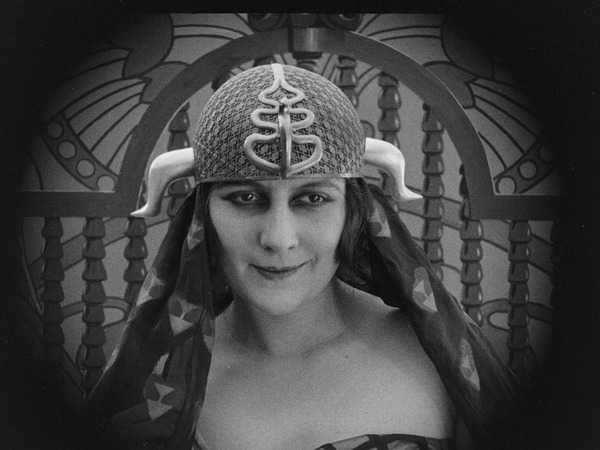L’ATLANTIDE
(US: Missing Husbands)
Jacques Feyder (FR 1921)
Jacques Feyder’s L’Atlantide was heralded as a revelation when it was released in Paris in June 1921. Pierre Benoît’s exotic 1919 novel, about the mysterious adventures of Morhange and Saint-Avit, two French legionnaires who come across the lost kingdom of Atlantis in the heart of the Sahara, and fall under the spell of its femme fatale queen Antinéa, had been a runaway best-seller. For his first major film, Feyder took a gamble; nothing but the real locations would do.
The film’s publicity referred to Feyder as “the man who dared”. He and his cast and crew went on a grueling 8-month shoot in Algeria, on location among the Touaregs in the Sahara and the Ahaggar (Hoggar) Mountains, with interiors filmed in a huge improvised tent studio outside Algiers. The lavish sets and costumes for Antinéa’s world were by Manuel Orazi, a noted art nouveau illustrator, jewelry designer, and poster artist (he also designed the film’s striking posters). It ended up being one of the most expensive French films to date, but the stunning result was a smash hit, which ran for a year in Paris and opened up a whole new world to fascinated cinemagoers. Louis Delluc rightly observed that the real star of the film, from the very opening shots, was the desert itself. L’Atlantide unwinds at a leisurely pace, relentlessly weaving its spell, bringing the romance and mystery of the desert alive, with its blazing sun, rippling sand dunes, and the solitude of its vast expanses.
This atmospheric romance firmly placed Feyder among the ranks of France’s leading directors. He went on to a long and distinguished career, directing such classics as Visages d’enfants, Thérèse Raquin (unfortunately now a lost film), Garbo’s The Kiss, Le Grand Jeu, Pension Mimosas, and La Kermesse héroïque.
The seductive, heartless Antinéa – Benoît’s literary creation was distinctly reminiscent of Ayesha in H. Rider Haggard’s 1887 novel She (a book review detailing various instances of possible plagiarism led Benoît to go to court and sue for libel, a case that he lost) – is played by Stacia Napierkowska, a famous dancer from the Paris Opéra Comique and the Folies-Bergère who had entered films in 1909. Today, Napierkowska seems miscast. She was Feyder’s second choice; he reportedly originally wanted Musidora. The rest of the cast is impeccable, especially Jean Angelo (memorable in Jean Epstein’s Les Aventures de Robert Macaire, 1923, and Henri Fescourt’s Monte-Cristo, 1929) as the ill-fated Morhange and Georges Melchior as the haunted Saint-Avit.
L’Atlantide’s exotic story continued to weave its spell for years afterwards, inspiring numerous Foreign Legion tales, led by P.C. Wren’s novel Beau Geste (1925), and contributing to the unleashing of a post-war surge of Orientalism and passion under desert stars, exemplified by Edith M. Hull’s The Sheik (1919, new edition 1921), a purple-prose best-seller in the Elinor Glyn vein that sold like wildfire, and immortalized Valentino for generations of moviegoers. As for L’Atlantide’s revelation of the visual splendours of the desert, nothing approaching its impact was seen on the screen until David Lean’s widescreen epic Lawrence of Arabia (1962).
Feyder’s film was remade by G.W. Pabst in 1932 in trilingual sound versions – French (L’Atlantide), German (Die Herrin von Atlantis), and English (The Mistress of Atlantis) – all ruled over by Brigitte Helm as the heartless queen. Other screen adaptations appeared over the years, including Siren of Atlantis (1949, Gregg G. Tallas, and uncredited, Arthur D. Ripley and John Brahm), with Maria Montez as Antinéa, and a 1972 French TV movie by Jean Kerchbron, starring Ludmila Tcherina (of Red Shoes fame). A 1961 French-Italian co-production, L’Atlantide / Antinéa, l’amante della città sepolta (Journey Beneath the Desert), directed by Edgar G. Ulmer and Giuseppe Masini, begun by Frank Borzage, with Haya Harareet as Antinéa, updated the classic adventure tale to include helicopters and nuclear testing in the Sahara. A far cry from Feyder’s magnificent, spellbinding original!
Catherine A. Surowiec
The Restoration: For years, L’Atlantide was only available in black & white prints, which did not do justice to the film’s dazzling pictorialism. Feyder used color in a very conscious way. In 1993, funded by the LUMIERE Project, the Nederlands Filmmuseum restored the film in color, based on a nitrate distribution print from Holland and a working print with French titles from the CNC.
The spectacular new 4K restoration that you will see was produced by Lobster Films in 2018 in their new Paris-based laboratory, in association with the CNC, the Cinémathèque française, and EYE Filmmuseum, mostly from the original camera negative and the nitrate elements used for the previous reconstruction. The Pordenone screening will be its world premiere.
Serge Bromberg

regia/dir: Jacques Feyder.
scen: Jacques Feyder, dal romanzo di/based on the novel by Pierre Benoît (1919).
photog: Georges Specht, Amédée Morin.
scg/des, cost: Manuel Orazi.
cast: Stacia Napierkowska (Antinéa), Jean Angelo (capitano/Capitaine Morhange), Georges Melchior (luogotenente/Lieutenant de Saint-Avit), Marie-Louise Iribe (Tanit-Zerga), André Roanne (luogotenente/Lieutenant Massard), René Lorsay (luogotenente/Lieutenant Ferrières), Génica Missirio (capitano/Capitaine Aymard), Abd-el-Kader Ben-Ali (Cegheïr-ben-Cheik), Mohamed Ben Noui (Bou-Djema), Paul Franceschi (archivista/archivist).
prod: Société Générale pour le Développement National et Commercial de la Cinématographie.
dist: Établissements Louis Aubert.
riprese/filmed: 1920.
première: 04.06/1921 (Gaumont-Palace, Paris).
copia/copy: DCP, 176′ (da/from 35mm: col., tinted/imbibito); did./titles: FRA.
fonte/source: Lobster Films, Paris.
Restauro/Restoration: digital (4K); Lobster Films, con/with CNC, Cinémathèque française, EYE Filmmuseum.


 Italiano
Italiano